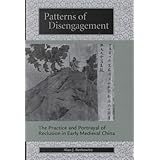
Average Reviews:

(More customer reviews)Are you looking to buy Patterns of Disengagement: The Practice and Portrayal of Reclusion in Early Medieval China? Here is the right place to find the great deals. we can offer discounts of up to 90% on Patterns of Disengagement: The Practice and Portrayal of Reclusion in Early Medieval China. Check out the link below:
>> Click Here to See Compare Prices and Get the Best Offers
Patterns of Disengagement: The Practice and Portrayal of Reclusion in Early Medieval China ReviewAlan J. Berkowitz's PATTERNS OF DISENGAGEMENT: THE PRACTICE AND PORTRAYAL OF RECLUSION IN EARLY MEDIEVAL CHINA, is a very scholarly book which cannot serve as an introduction for someone who knows nothing about Chinese history. But if one has a basic knowledge and an interest in this fascinating subject (and one does not have to be fluent in the language), it is a delight. It is also a vital contribution to a subject which is becoming controversial: the true nature and authenticity of the Confucian tradition. That tradition is all too often represented as a shallow and self-serving creed, advocating conformity, respect for authority, and meticulous observation of outward manifestations of propriety and etiquette at the expense of strength of character-- essentially a "go along to get along" mentality.Berkowitz's book suggest that there is another and more authentic "Confucian tradition", and its reality does not depend upon the answer to the question of whether or not Confucius was really a great teacher or even if he ever lived. For the tradition in question dates back centuries before he is believed to have lived, and he was probably never more than a symbol of it at best. Having survived for three millennia, this tradition is the oldest ethical system in the world and the one most consistent with the freedom and dignity of man. In its most highly developed version, it can be defined thus: It is the responsibility of the man of wisdom to live a righteous life and to teach righteousness, both through example and precept, above all to the ruler he serves. If he fails to persuade his suzerain to rule virtuously, he must retire from all involvement in government and decline all invitations to serve, no matter ho such retirement reduces his quality of life or indeed, places him in physical jeopardy.
Accordingly, the trait which is most typical of practitioners of reclusion in ancient China was strength of character. "That they maintained their mettle, their resolve, their integrity-- their personal moral or religious values-- in the face of adversity, threat or temptation, was their distinction." (p. 5). The "Confucian ideal" presented here is the very antithesis of the later and debased version of it, in that its practitioner was defiant, stubborn, passionate, honest, and unconcerned about outward appearances-- at times even downright eccentric. The first recluses honored in Chinese tradition are Bo Yi and Shu Qi, who lived around 1000 B.C.E. at the close of the Shang Dynasty and starved themselves to death in the wilderness rather than eat the grain of the conquering Zhou Dynasty. As Berkowitz says: "Bo Yi and Shu Qi reputedly died for their principles: they lost their lives but gained lasting recognition as manifestations of the Ethical Martyr. Sometimes paid homage, sometimes rebuked, they were left out of virtually no discussion bearing on withdrawal, and their legendary suicide lent precedent to kindred action on the part of other morally uncompromising individuals." (p. 40)
Not all individuals dealt with by Berkowitz were forced by circumstances to choose death, and those who were able to practice a life of principled reclusion could be happy indeed. Berkowitz describes their lifestyles with a fondness that only those of us who are hermits at heart can understand. There are for instance the Four Hoaryheads, who retired from service under the tyrannical Qin Dynasty (221-206 BCE) because "wealth and nobility may awe people, but that can't compare to the way being poor and humble frees the will." (p. 68). Wives play an important part in the lives of these recluses, and are often shown to have a stronger character than their husbands. An account written during the Han Dynasty (206 BCE to 221 CE) describes how the wife of Laolaizi reacted when she returned from gathering firewood to learn that her husband had accepted an offer of position from a king: "I have heard that those who can offer meals can follow up with the flogging whip; ones who offer proposals of high office can follow up with the executioner's ax. I am not someone who is able to be the wife of a man who is under the control of another." At that she fled, and Laolaizi ran after her, declaring that he had changed his mind and would continue in the simple and rustic existence they had chosen. (p. 112). But the most appealing section is that which Berkowitz devotes to Tao Yuan Ming, also known as Tao Qian (365-427), the first practitioner of reclusion to have left behind an extensive body of writings. At Tao said, "My instinct is all for freedom and will not brook discipline or restraint." One can be grateful that he, like others to follow, decided to follow his natural instinct "for hills and mountains" for the poetry he left us is wonderful indeed.
Patterns of Disengagement: The Practice and Portrayal of Reclusion in Early Medieval China Overview
Want to learn more information about Patterns of Disengagement: The Practice and Portrayal of Reclusion in Early Medieval China?
>> Click Here to See All Customer Reviews & Ratings Now
0 comments:
Post a Comment